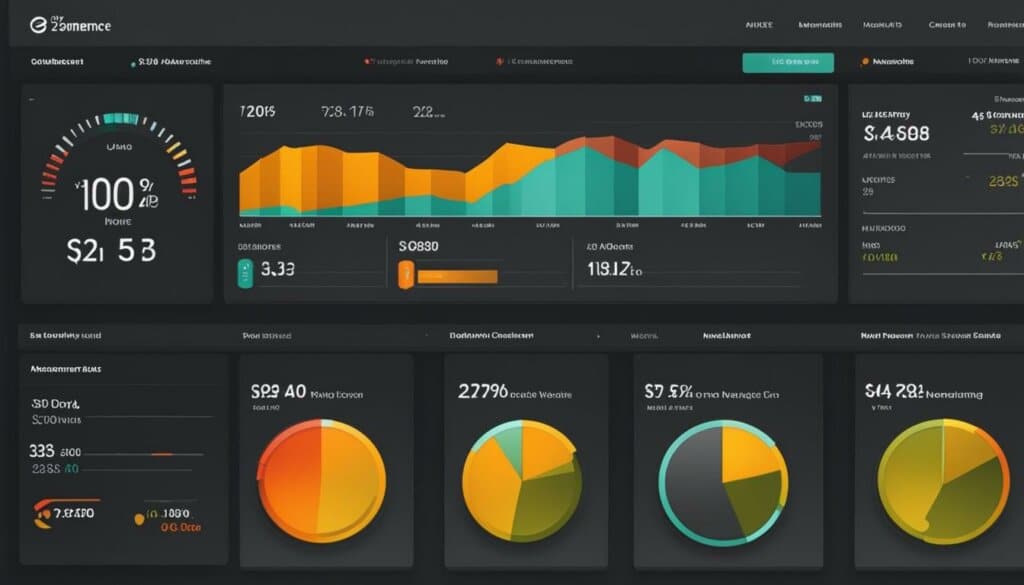Table of Contents
An e-commerce dashboard is a powerful tool that allows businesses to effectively manage their online sales strategy and make data-driven decisions. With features like code-free automation and Shopify reports, merchants can gain valuable insights into sales, traffic, products, customers, abandoned checkouts, inventory, and marketing campaigns. These insights enable merchants to understand the health of their store, identify trends, and optimize their sales to enhance overall business performance. Shopify is a leading e-commerce platform that offers a variety of reports and analytics to help merchants maximize their sales potential.
Key Features of an E Commerce Dashboard
An e-commerce dashboard offers various key features that provide valuable insights into different aspects of a business. These features enable merchants to track performance, identify trends, and make informed decisions to optimize sales. Let’s explore the key features in detail:
Sales Report
The Sales Report provides a comprehensive breakdown of sales activity, including order numbers, order value, average order value, and returning customers. With this information, merchants can assess the overall sales performance of their e-commerce store.
Traffic Report
The Traffic Report offers insights into website visitors and their sources. By understanding customer acquisition channels, merchants can analyze the effectiveness of their marketing efforts and make data-driven decisions to optimize customer engagement.
Products Report
The Products Report provides detailed information on individual products, such as sales numbers, average order value, and total revenue generated. Merchants can use this data to identify their best-selling products, evaluate product performance, and optimize their product offerings.
Customer Report
The Customer Report offers valuable insights into customer demographics and locations. This information helps merchants understand their target audience better and tailor their marketing and sales strategies to effectively reach their customers.
Abandoned Checkouts Report
The Abandoned Checkouts Report helps re-engage customers who have left items in their carts without completing the purchase. With this feature, merchants can analyze the reasons behind abandoned checkouts and implement strategies to recover those sales.
Inventory Report
The Inventory Report provides information on product quantities, costs, sales prices, profit margins, and inventory value. This feature allows merchants to effectively manage their inventory, track product availability, and ensure efficient stock control.
Marketing Reports
Marketing Reports analyze the effectiveness of marketing campaigns and channels. By tracking key metrics and analyzing campaign performance, merchants can optimize their marketing strategies and allocate resources to the most successful channels.
| Key Features |
|---|
| Sales Report |
| Traffic Report |
| Products Report |
| Customer Report |
| Abandoned Checkouts Report |
| Inventory Report |
| Marketing Reports |
An e-commerce dashboard provides merchants with a detailed overview of their business performance. With features like the Sales Report, Traffic Report, Products Report, Customer Report, Abandoned Checkouts Report, Inventory Report, and Marketing Reports, merchants can gain valuable insights and optimize their sales strategy for better results.
Benefits of an E Commerce Dashboard
An e-commerce dashboard offers several benefits for businesses. First, it improves decision-making by providing valuable insights into customer behavior, sales patterns, and market trends. With these insights, merchants can make informed decisions to optimize their store and increase sales. Second, it enhances customer understanding by providing information on customer demographics, interests, and behavior. This allows merchants to tailor their marketing and sales strategies to effectively target their customers. Third, it increases efficiency by identifying bottlenecks in operations and optimizing processes to improve productivity. Fourth, it enables better targeting by understanding customer behavior and effectively utilizing marketing efforts. Fifth, it provides a competitive advantage by tracking and optimizing store performance to stay ahead of competitors. Overall, an e-commerce dashboard is a valuable tool for businesses looking to maximize their sales potential and grow their online presence.
| Benefits of an E Commerce Dashboard |
|---|
| Improves decision-making |
| Enhances customer understanding |
| Increases efficiency |
| Enables better targeting |
| Provides a competitive advantage |
How to Create an Optimal E Commerce Dashboard
Creating an optimal e-commerce dashboard requires careful planning and consideration. By following these key steps, businesses can develop a dashboard that tracks performance and drives sales growth.
Determine Your Specific Metrics and KPIs
First and foremost, businesses need to identify the specific metrics and key performance indicators (KPIs) that align with their sales goals. This involves identifying the data points they want to track, such as sales numbers, website traffic, customer demographics, and marketing campaign performance. By defining these metrics, businesses can focus on the data that matters most to their success.
Choose a Customizable Dashboard Platform
Once the metrics are determined, it’s important to select a dashboard platform or software that offers customizable features and integrates seamlessly with the e-commerce platform. This ensures smooth data collection and analysis. The chosen platform should provide the necessary tools and functionalities to visualize and interpret the data effectively.
Design a User-Friendly Interface
A user-friendly interface is crucial for an optimal e-commerce dashboard. It should provide a clear and concise overview of key metrics, making it easy for users to understand and interpret the data. Choosing appropriate visualization tools, such as graphs and charts, can further enhance data presentation and facilitate quick decision-making.
Automate Data Updates for Real-Time Insights
Real-time insights are essential for making accurate and timely business decisions. By automating data updates, businesses can ensure that their dashboard provides up-to-date information that reflects the current state of their e-commerce operations. This allows for proactive adjustments to sales strategies and quick identification of trends.
Evaluate and Optimize Regularly
Creating an optimal e-commerce dashboard is an ongoing process. It’s essential for businesses to regularly evaluate their dashboard’s performance and seek feedback from users. This feedback can help identify areas for improvement and guide necessary adjustments to enhance usability and functionality. By continuously optimizing the dashboard, businesses can ensure it remains effective in tracking performance and supporting sales growth.

By following these key steps, businesses can create an optimal e-commerce dashboard that effectively tracks performance and drives sales growth. It’s important to remember that the dashboard should be dynamic and adaptable, keeping pace with evolving business needs and industry trends.
Overcoming Challenges in E Commerce Dashboard Implementation
Implementing an e-commerce dashboard can pose several challenges for businesses. One common challenge is handling excessive data and prioritizing relevant insights. To overcome this, businesses should focus on key metrics that align with their goals and prioritize the quality of data analyzed over quantity.
Another challenge is integrating data from multiple sources. Businesses should choose a dashboard tool that can seamlessly integrate with different data sources, creating a centralized hub for analysis.
Data security concerns also pose a challenge, and businesses should prioritize compliance with regulations and conduct regular security audits.
Legacy processes and mindset shifts can make it challenging to transition from manual to digital operations. Training and change management initiatives can help facilitate this transition.
Finally, interpretation hiccups can occur when relying solely on data without considering its meaning and taking appropriate action. Regularly reviewing and interpreting data, and using it to drive decision-making, can overcome this challenge.
Implementing an e-commerce dashboard requires businesses to address various challenges related to data, integration, security, and change management. By recognizing these challenges and implementing appropriate strategies, businesses can successfully overcome the obstacles and unlock the full potential of their e-commerce dashboard.
Trends in E Commerce Dashboard and Data Analytics
The field of e-commerce dashboards and data analytics is rapidly evolving, with several trends shaping the future. Businesses are leveraging advanced technologies to gain deeper insights and maximize their sales potential. Let’s explore some of the key trends in e-commerce dashboard and data analytics:
Predictive Analytics
The utilization of AI and machine learning in predictive analytics is becoming increasingly important in the e-commerce industry. By analyzing historical data and patterns, businesses can anticipate future trends, customer behavior, and market demands. This empowers them to stay ahead of the competition and make informed decisions based on accurate predictions.
AI-Driven Interactive Insights
The integration of artificial intelligence is transforming data presentation in e-commerce dashboards. AI algorithms provide interactive and personalized insights, making it easier for businesses to understand complex data sets. This enables stakeholders to explore data, discover trends, and gain actionable insights through intuitive visualizations.
Real-Time Data Updates
Timely and up-to-date information is invaluable for making agile and informed decisions. Real-time data updates in e-commerce dashboards provide businesses with a comprehensive view of their operations, allowing them to respond swiftly to changing market dynamics. Real-time updates enable businesses to spot trends as they emerge and capitalize on new opportunities.
Customizability
Businesses are seeking unique dashboard features tailored to their specific needs. Customizability allows stakeholders to design their dashboards according to their preferences and performance metrics. From selecting relevant KPIs to choosing visualization tools, businesses can create a dashboard that aligns with their goals and presents data in a clear and meaningful way.
A/B Testing
Experimenting with different visual representations is crucial for enhancing data understanding. The integration of A/B testing in e-commerce dashboards enables businesses to test and compare different versions of their dashboards. By evaluating the effectiveness of different designs, businesses can optimize their data visualization and improve decision-making.
Ongoing Learning and Feedback
Continuous improvement is vital in using e-commerce dashboards effectively. Stakeholders should actively seek feedback from users, analyze their data usage patterns, and identify areas for enhancement. Ongoing learning ensures that businesses stay up-to-date with the latest trends and technologies, enabling them to harness the full potential of their e-commerce dashboards.
To stay ahead in the dynamic e-commerce landscape, businesses must embrace these trends in e-commerce dashboard and data analytics. By leveraging predictive analytics, AI-driven insights, real-time data updates, customizability, A/B testing, and ongoing learning, businesses can optimize their sales strategies, make data-driven decisions, and drive sustainable growth.
Conclusion
An e-commerce dashboard is a powerful tool that unlocks valuable sales insights and enables businesses to make data-driven decisions. By utilizing features such as sales reports, traffic reports, customer reports, and marketing reports, businesses can gain a deeper understanding of their online sales strategy. Through effective data analysis, businesses can optimize their store, effectively target customers, increase efficiency, and gain a competitive advantage in the market.
Overcoming challenges in implementing an e-commerce dashboard, such as handling excessive data and integrating data from multiple sources, is crucial in harnessing its full potential. Regularly staying updated with trends in data analytics, featuring predictive analytics and real-time data updates, further enhances the effectiveness of an e-commerce dashboard.
In conclusion, an e-commerce dashboard is an essential component of a successful online sales strategy. It provides businesses with the valuable sales insights they need to drive growth and maximize their sales potential. By leveraging the power of an e-commerce dashboard and making data-driven decisions, businesses can thrive in today’s competitive e-commerce landscape.
FAQ
What is an e-commerce dashboard?
An e-commerce dashboard is a powerful tool that allows businesses to effectively manage their online sales strategy and make data-driven decisions. It provides valuable insights into sales, traffic, products, customers, abandoned checkouts, inventory, and marketing campaigns.
What are the key features of an e-commerce dashboard?
The key features include various types of reports that provide insights into different aspects of a business. These reports include Sales Report, Traffic Report, Products Report, Customer Report, Abandoned Checkouts Report, Inventory Report, and Marketing Reports.
What benefits does an e-commerce dashboard offer?
An e-commerce dashboard offers several benefits including improved decision-making, enhanced customer understanding, increased efficiency, better targeting, and a competitive advantage.
How can I create an optimal e-commerce dashboard?
To create an optimal e-commerce dashboard, businesses need to determine their specific metrics and KPIs, choose a suitable dashboard platform or software, design a user-friendly interface, automate data updates, and regularly evaluate and optimize their dashboard.
What challenges can arise in implementing an e-commerce dashboard?
Challenges in implementing an e-commerce dashboard can include handling excessive data, integrating data from multiple sources, addressing data security concerns, transitioning from manual to digital operations, and interpreting data accurately.
What are the trends in e-commerce dashboard and data analytics?
Trends in e-commerce dashboard and data analytics include predictive analytics, AI-powered data presentation, real-time data updates, customizability, integration of A/B testing, and ongoing learning for continuous improvement.







